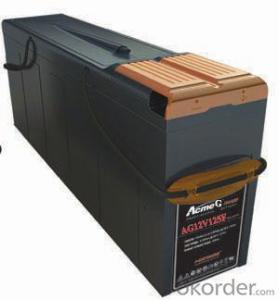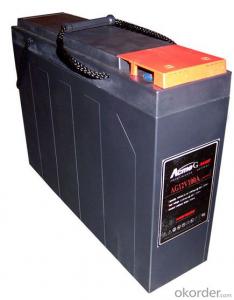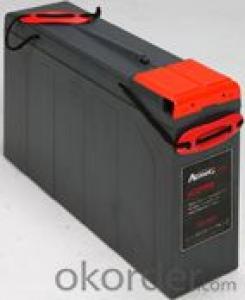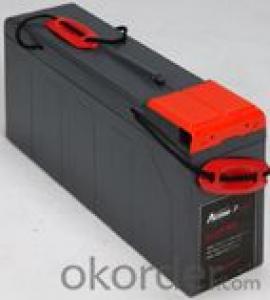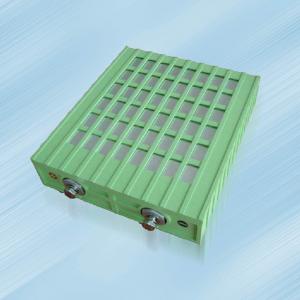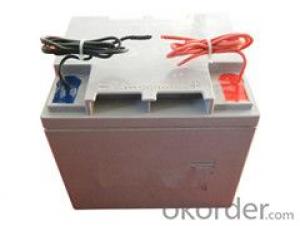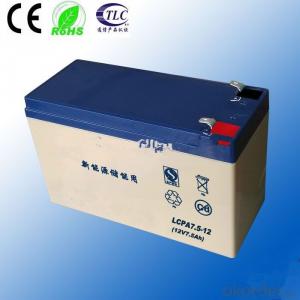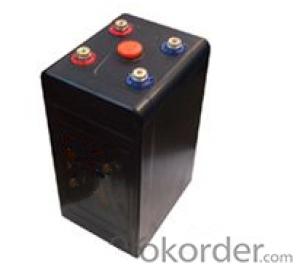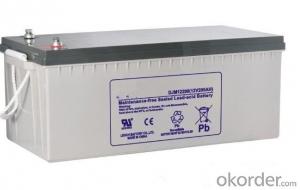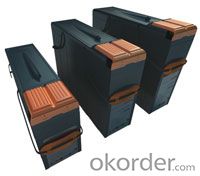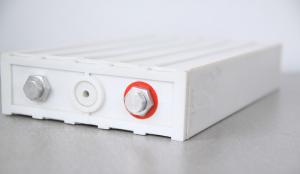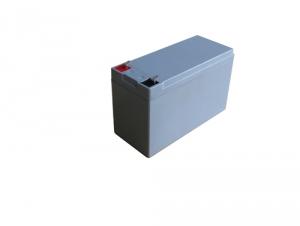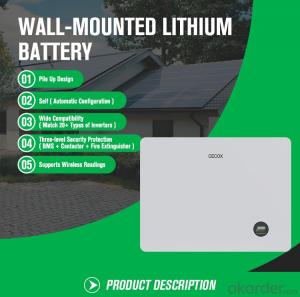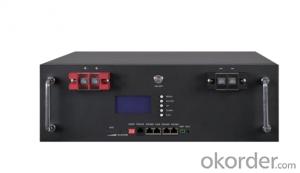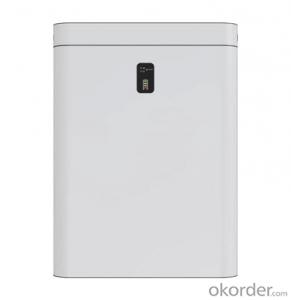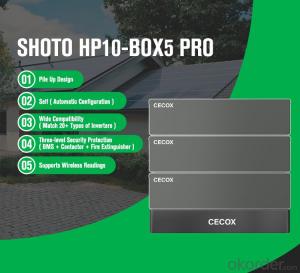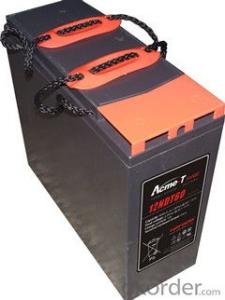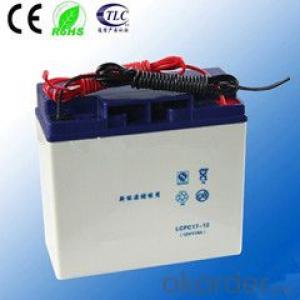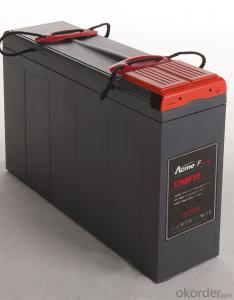Gel Battery the AcmeG Series Battery AG12V50F
- Loading Port:
- Shanghai
- Payment Terms:
- TT OR LC
- Min Order Qty:
- 1000 unit
- Supply Capability:
- 100000 unit/month
OKorder Service Pledge
OKorder Financial Service
You Might Also Like
Range summary
The AcmeG range front access gel batteries is designed based on the Acme series, using the polymer gel electrolyte with real front access structure. The state-of the-art internal and external design ensures AcmeG the high reliability and makes the installation quite simple and safe when placed on a standard relay rack tray or in a closed cabinet. AcmeG range gel battery is designed with high energy density and suitable for 19". 23" rack or cabinet.
Technical features
Long life
Using the polymer gel electrolyte
4BS paste technology
Special paste formula
Special patented grid alloyWide operational temperature range
Excellent charging and discharging ability at low temperature
Decline the water-loss at high temperaturespecial structure
real front access structure makes the installation and maintenance squite simple and safe
suitable for 19". 23" rack or cabinet
The specially centralized venting system ensures the small gas be vented our of the closed cabinet
Type: | AG12V50F | |
Voltage: | 12V | |
Nominal Capacity: | 50Ah(C10) | 50Ah(10 hours rate:) |
Length: | 390mm | |
Width: | 105mm | |
Height: | 200mm | |
Height with termial: | 200mm | |
Weight: | 21.3Kg |
Compliant standards
Designed to be compliant with:
IEC 60896-2
BS 6290 Part 4
Telcordia SR-4228
EUROBAT GUIDE
UL
Manufactured under system ISO9001 & ISO14001 by NARADA
Battery installation compliant with:
EN 50272-2 or local equivalents
Main applications
Telecom standby and cyclical applications
UPS
Power plant and power transfer system
Solar energy system
Emergency lighting system
Products characteristics:
float voltage: 2.25Vpc at 77oF(25oC) , Equalization charge voltage: 2.40Vpc at 77oF(25oC)
Self discharge rate: < 2% pre month at 68oF(20oC)
Design life: more than 12 years at 68oF(20oC)
Shelf life: 6 months at 68oF(20oC)
Recombination efficiency: >99%
the Pressure at which the valve opens & reclose is Opened at 10 to 35kpa(1.45psi to 5.08psi) and
closed at 3 to 15 kpa (0.44psi to 2.18psi)
Temperature ranges: -40oC to 50oC
Terminal Hardware Torque:10±0.1N m
Container Material: ABS (V0 optional)
FAQ
![]() What is a Gel Cell Battery?
What is a Gel Cell Battery?
A gel battery design is typically a modification of the standard lead acid automotive or marine battery. A gelling agent is added to the electrolyte to reduce movement inside the battery case. Many gel batteries also use one way valves in place of open vents, this helps the normal internal gasses to recombine back into water in the battery, reducing gassing. "Gel Cell" batteries are non-spillable even if they are broken. Gel cells must be charged at a lower voltage (C/20) than flooded or AGM to prevent excess gas from damaging the cells. Fast charging them on a conventional automotive charger may be permanently damage a Gel Battery.
![]() What is sulfation of batteries?
What is sulfation of batteries?
Sulfation is the formation or deposit of lead sulfate on the surface and in the pores of the active material of the batteries' lead plates. If the sulfation becomes excessive and forms large crystals on the plates, the battery will not operate efficiently and may not work at all. Common causes of battery sulfation are standing a long time in a discharged condition, operating at excessive temperatures, and prolonged under or over charging.
![]() How long a battery can last?
How long a battery can last?
The service design life of a battery are vary considerably with how it is used, how it is maintained and charged, temperature, and other factors.
![]() Do batteries self-discharge when not in use?
Do batteries self-discharge when not in use?
All batteries, regardless of their chemistry, self-discharge. The rate of self-discharge depends both on the type of battery and the storage temperature the batteries are exposed to. However, for a good estimate, Narada batteries self-discharge approximately 4% per week at 80ĄăF.
- Q:What is a maintenanceable battery?
- Maintenance-free battery due to its own structure on the advantages of electrolyte consumption is very small, in the life of the basic need not add distilled water.
- Q:What is the meaning of the battery above 12v65Ah?
- Voltage 12V, current 65AH, that is the capacity of 65A. (A is the unit of current. H is the time unit)
- Q:How does the battery increase the voltage?
- You can use the same battery in series, with 5 12v battery in series becomes 60v, if you need the current is relatively small, you can use DC-DC module to 12v voltage rise to 60v.
- Q:How to repair the battery?
- Connect the positive and negative output of the repair instrument to the positive and negative pole of the battery, open the repair instrument, repair the battery. The first repair time should be no less than 48 hours.
- Q:80ah how much battery storage capacity?
- Is 80AH. Understood to discharge at 80 amps for about 1 hour (but not to say that after 1 hour is finished, there is still electricity). In theory, this is your battery power.
- Q:How is the capacity of the battery defined?
- General circuit has a battery protection circuit, once the battery voltage is less than 10.8V will automatically cut off the electricity to prevent the battery because of over-discharge and damage. (Nominal value of 12V battery internal six cell grid) with the battery discharge current multiplied by the discharge time to express how much energy the battery can store, is a very image of a measure. The greater the value of the battery, indicating that the battery can store more energy. But does not mean that the battery can use such a large current discharge.
- Q:How should the battery be well maintained?
- Voltage check the state of the battery standard voltage should be maintained between 12.2 ~ 12.7V. If the voltage is too low should be charged, the charge should be kept small charge for a long time. Battery charging need to use a professional charger, the owner will not try to charge their own, the owner can only keep the engine running on the battery can be charged. If the battery aging should be replaced.
- Q:Lead-acid battery how to maintain?
- After 5 hours of repair, the excess electrolyte is sucked out with a straw, and if the electrolyte is sucked out into black, it indicates that the battery is severely grounded and that the battery is difficult to repair.
- Q:Maintenance-free battery how to detect it?
- Do not always check the color of the electric eye for maintenance-free batteries. Green for the full power; black for the lack of electricity, need to be added to charge; gray or light yellow for the electrolyte is insufficient, because maintenance-free battery can not add liquid, should immediately replace the battery.
- Q:What battery does the van use?
- The most obvious feature of lead-acid batteries is the top of the plastic cover can be unscrewed, there are ventilation holes above. These fillers are used to fill pure water, check the electrolyte and the use of exhaust gas. In theory, lead-acid batteries need to check the density of each electrolyte and the level of liquid, if there is a need to add distilled water. But with the upgrading of battery manufacturing technology, lead-acid battery development for the lead-acid maintenance-free batteries and colloidal maintenance-free batteries, lead-acid batteries do not need to add electrolyte or distilled water. Mainly the use of positive electrode to produce oxygen can be absorbed in the negative oxygen cycle, to prevent water reduction. Lead-acid water batteries are mostly used in tractors, tricycles, car start, etc., and maintenance-free lead-acid battery wider range of applications, including uninterruptible power supply, electric vehicle power, electric bicycle batteries. Lead-acid batteries according to the application needs to be divided into constant current discharge (such as uninterruptible power supply) and instantaneous discharge (such as car to start the battery).
1. Manufacturer Overview |
|
|---|---|
| Location | |
| Year Established | |
| Annual Output Value | |
| Main Markets | |
| Company Certifications | |
2. Manufacturer Certificates |
|
|---|---|
| a) Certification Name | |
| Range | |
| Reference | |
| Validity Period | |
3. Manufacturer Capability |
|
|---|---|
| a)Trade Capacity | |
| Nearest Port | |
| Export Percentage | |
| No.of Employees in Trade Department | |
| Language Spoken: | |
| b)Factory Information | |
| Factory Size: | |
| No. of Production Lines | |
| Contract Manufacturing | |
| Product Price Range | |
Send your message to us
Gel Battery the AcmeG Series Battery AG12V50F
- Loading Port:
- Shanghai
- Payment Terms:
- TT OR LC
- Min Order Qty:
- 1000 unit
- Supply Capability:
- 100000 unit/month
OKorder Service Pledge
OKorder Financial Service
Similar products
New products
Hot products
Hot Searches
Related keywords
